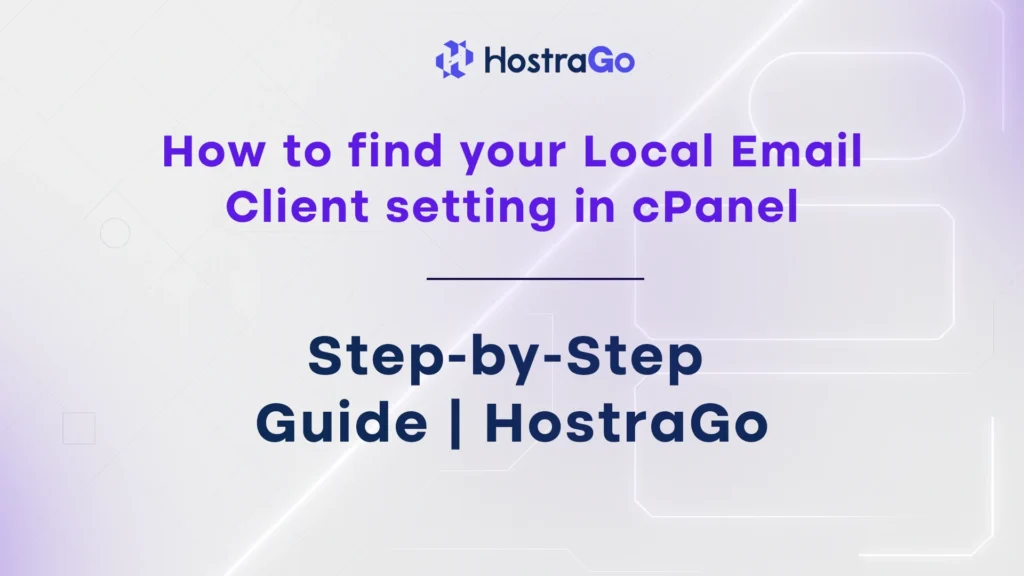If you’re wondering how to find your Local Email Client setting in cPanel, you’re not alone. Configuring your email client correctly is essential for smooth email communication, whether you’re using Outlook, Thunderbird, Apple Mail, or any mobile device. cPanel simplifies this process by providing you with automatic and manual configuration settings directly inside its interface.
In this comprehensive guide, we’ll walk you through the step-by-step process of locating your How to find your Local Email Client setting in cPanel, so you can start sending and receiving emails without hassle.
Why Do You Need Local Email Client Settings?
When you create an email account on your hosting server via cPanel, you may want to connect that account to:
- Desktop email clients (like Microsoft Outlook or Thunderbird)
- Mobile apps (like iPhone Mail or Android Gmail app)
- Web applications
The Local Email Client Settings in cPanel provide:
- Incoming & outgoing server details
- Port numbers
- Security protocols (SSL/TLS)
- Auto-configuration scripts
Having the correct configuration ensures:
- Seamless email syncing
- Secure connections
- No email delivery failures
👉 For more web hosting guides, visit our Hostrago Knowledge Base where you’ll find tutorials on everything from WordPress setup to DNS management.
Step-by-Step Guide: How to Find Your Local Email Client Setting in cPanel
Step 1: Login to Your cPanel Account
Start by logging into your cPanel account using your username and password.
Step 2: Access Email Accounts Section
Once you’re logged into cPanel:
- Scroll down to the Email section.
- Click on Email Accounts.

Step 3: Select the Email Account
- Locate the email account for which you want the client settings.
- Click Connect Devices or Manage next to the email account.

Step 4: Review Mail Client Manual Settings
You will now see:
- Mail Client Manual Settings
- Secure SSL/TLS Settings (Recommended)
- Non-SSL Settings (Not Recommended)
The settings provided include:
- Incoming Server (IMAP/POP3)
- Outgoing Server (SMTP)
- Port numbers
- Username & Password
- SSL Encryption

Step 5: Use Auto Configuration Scripts (Optional)
If your email client supports it, you can also download auto-configuration scripts directly from this page for:
- Microsoft Outlook
- iOS Devices
- MacOS Mail
- Thunderbird

Secure Email Setup Recommendations
- Always use SSL/TLS for secure email transmission.
- Use strong passwords to protect your accounts.
- Keep your email client software updated.
For professional email hosting solutions, check out our Hostrago Email Hosting Services to get enterprise-grade reliability.
Frequently Asked Questions
Q1: Can I use both IMAP and POP3?
Yes, but IMAP is recommended for multiple device sync while POP3 is better for single device access.
Q2: What if auto-configuration fails?
Use the manual settings provided in cPanel to manually configure your client.
Q3: Are my emails safe using cPanel email?
Yes, as long as you use SSL/TLS encryption and strong passwords.
Final Thought
Finding your How to find your Local Email Client setting in cPanel is quick and easy, thanks to cPanel’s built-in tools. Whether you’re configuring desktop email clients or mobile apps, these settings ensure secure and reliable email delivery. Always double-check your SSL settings and server names to avoid connection issues.
At Hostrago, we are dedicated to helping you simplify your web hosting and email management. Visit our full Hostrago Knowledge Base for more tutorials and expert advice.


